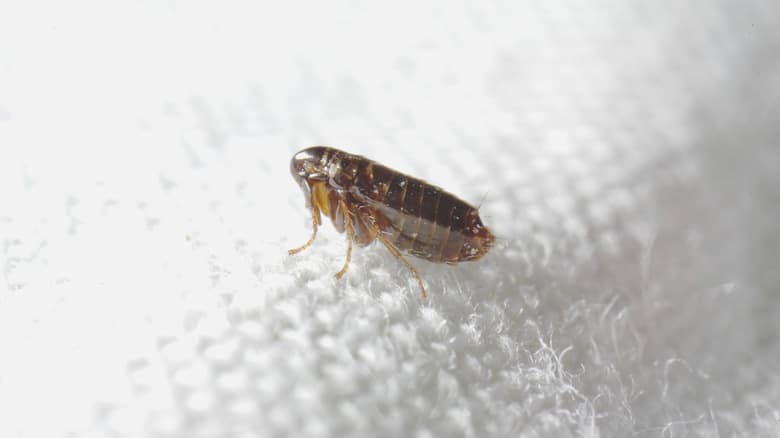Fleas are persistent, blood-sucking insects that can swiftly transform your home into an itchy battleground for you and your furry companions. These minuscule menaces reproduce at an alarming rate, and their bites can cause irritating, uncomfortable bumps that can even trigger allergic reactions. If you’ve discovered signs of a flea infestation, don’t despair! This comprehensive guide equips you with the knowledge and strategies necessary to combat these unwelcome guests and achieve successful fleas pest control.
Introducing the Flea Foe
Fleas are parasitic hitchhikers that belong to the order Siphonaptera. Their flattened bodies allow them to move effortlessly through animal fur and feathers, while their powerful hind legs propel them on impressive jumps relative to their size. These external parasites feed on the blood of warm-blooded animals, including dogs, cats, rabbits, rodents, and even humans in rare cases.
The flea life cycle is complex and plays a crucial role in developing a successful eradication strategy. Adult female fleas lay tiny eggs on their host animal, typically in areas where the pet spends a lot of time, such as bedding, carpets, or furniture. These eggs fall off the animal and land in the environment, where they hatch into larvae within a few days. Flea larvae are worm-like and feed on organic debris, including flea feces (dried blood) and other pet dander. After feeding for several weeks, the larvae spin cocoons and enter the pupal stage. Pupae are resistant to many insecticides, making it essential to target all life stages of the flea for complete elimination. Finally, adult fleas emerge from their cocoons, seeking their first blood meal to begin the cycle anew.
Detecting Flea Problems
How do you know if you have fleas? Here are some tell-tale signs:
- Flea bites: Small, itchy, red bumps often clustered around the ankles and lower legs.
- Flea feces: Tiny black specks that resemble ground pepper found on your pet or in carpets.
- Pets scratching excessively: Pets may scratch, bite, or groom themselves more than usual.
- Seeing live fleas: Adult fleas are small, brown, and can jump quickly.
DIY Pest Control
If you catch a flea infestation early, you may be able to tackle the problem yourself. Here’s how:
- Treat Your Pets: Use vet-approved flea control products on all your pets. This might include topical medications, oral treatments, and flea shampoos.
- Wash Pet Bedding: Wash all pet bedding in hot water and dry on high heat.
- Vacuum Thoroughly: Vacuum carpets, furniture, and floors thoroughly to remove flea eggs, larvae, and adult fleas. Empty the vacuum bag carefully outside.
- Apply Insecticides: Use an insecticide approved for indoor flea control, following the label instructions carefully.
Professional Pest Control
When a DIY approach seems overwhelming or ineffective, consider seeking help from a professional pest control company. Here’s why professional help can be advantageous:
- Expertise and experience: Professional exterminators have the knowledge and experience to identify the source and extent of a flea infestation. They understand the flea life cycle and can target all flea stages, including hard-to-reach flea eggs and pupae that may be hiding in carpets, furniture, or cracks and crevices.
- Stronger insecticides: Professional pest control companies have access to more potent insecticides that are not available to the general public. These insecticides are formulated to kill adult fleas, larvae, and flea eggs, ensuring a more thorough and long-lasting elimination.
- Targeted treatment: Professional exterminators will assess your specific situation and tailor a treatment plan to address the flea infestation effectively. This may involve a combination of flea control products, such as sprays, fogs, or baits, depending on the severity of the problem.
- Preventative measures: In addition to flea eradication, some professional pest control companies offer preventative measures to help stop future infestations. This may include ongoing monitoring and treatment programs to keep your home flea-free.
Preventative Measures
Once you’ve won the battle against fleas, you’ll want to keep them from coming back. Here’s how:
- Regularly treat pets: Use flea preventative treatments for your pets year-round.
- Vacuum regularly: Vacuuming helps remove flea eggs and larvae.
- Wash bedding frequently: Wash your bedding and pet bedding regularly to prevent flea infestations.
Important Considerations
- Flea control takes time: It may take several weeks to fully eliminate fleas due to their life cycle. Keep up with treatment protocols.
- Consult a vet: Talk to your vet about the best flea treatments for your pets, especially if they have sensitivities or allergies.
- Treat your yard: If pets spend time outside, consider treating your yard for fleas.
Choosing Flea Control Products
When choosing flea control products, consider:
- Type of pet: There are different products for dogs and cats.
- Age and health of your pet: Some products are not suitable for puppies, kittens, or pets with health conditions.
- Ingredients: Opt for insecticides such as pyrethrins or permethrins.
Note: If you have children or other pets, carefully follow instructions when using any flea control products.
When Considering Hiring a Professional
If you decide professional pest control is right for you, here are some important factors to keep in mind:
- Licensing and experience: Make sure the pest control company is licensed and has experience dealing with flea infestations.
- Treatment plan: Ask about their approach to flea elimination.
- Cost: Get quotes from several companies before choosing one.
Let’s Get Rid of Fleas! By following the tips in this guide and using effective pest control methods, you can successfully free your home from fleas!

